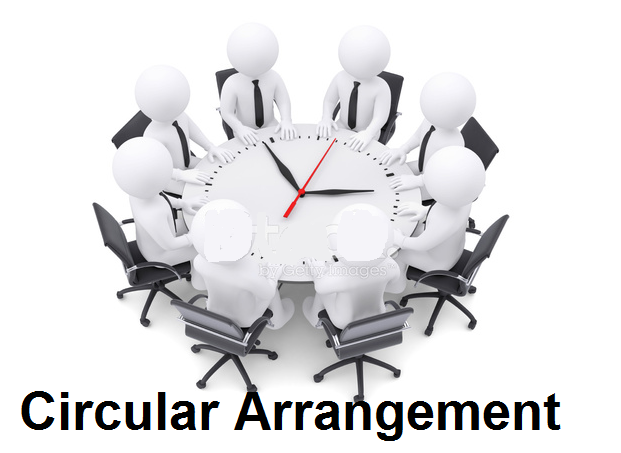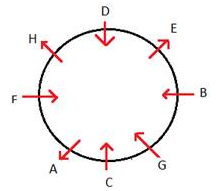In continuation with our article on Sitting Arrangement which we posted yesterday, here we are posting some tricks to solve more complicated questions from the topic which are becoming very common in the recent Banking Exams.
No matter what the model is, the following points are to be noted in order to solve the questions easily.
Read the entire puzzle and understand the statements correctly
- Identify the statements that give definite information.

- For instance let us take three statements and evaluate them
Statement 1: A is to the left of B.
The data in the statement is basic but not definite as the statement ONLY says that A is to the left of B. but, it does not specify where A is located from B.
Statement 2: A is second to the left of B. The data in the statement is definite as it clearly states that A is placed second to the left of B.
Some important points to be kept in mind before solving the sitting arrangement puzzles are:
- If A is sitting immediate left of B, it means B is on immediate right of A.
- To avoid confusion of left and rights in circular and other shapes’ seating arrangement problems, you should assume that all people are facing to center (unless and until they specify the direction).
- It’s always better idea to assume you are one among them so that it will be easier for you to get an idea of the arrangement.
- If you are unable to get the idea from a line then better skip that line and go to next line. You can revisit to the skipped line after getting another clue.
For circular sitting arrangement those objects which are facing inwards to the center are favorable to us which means LEFT-RIGHT position are same to reference object and those objects which are facing outwards are unfavorable to us which means LEFT-RIGHT position are opposite to reference object.
Circular Arrangement reasoning 2
Eight friends-A, B, C, D, E, F, G and H-are sitting around a circular table not necessarily in the same order. Three of them are facing outward while five are facing towards the centre. There are equal number of males and females in the group. C is facing the centre. E is sitting third to the right of C. F is sitting third to the left of E. Three persons are sitting between F and B. The immediate neighbours of B are females. G is sitting third to the right of F. D is sitting third to the right of A. A is not an immediate neighbour of E. The immediate neighbours of E are males and are facing the centre. The immediate neighbours of D are females and face outside. The one sitting third to the left of B is a male. No female is an immediate neighbour of G.
Question 1: Who sits to the immediate right of E.
- a) A b) B c) C d) D e) E
Question 2: Who sits to the immediate right of H.
- a) A b) B c) C d) D e) E
Question 3: Who sits to the immediate right of G.
- a) A b) B c) C d) D e) E
Question 4: Who sits diagonally opposite of F.
- a) A b) B c) C d) D e) E
Question 5: Who sits diagonally opposite of C.
- a) A b) B c) C d) D e) E
Question 6: Which of the following is odd man out
- a) A b) B c) C d) D e) F
Solution:
 Practice all 11 sets of advance level Sitting arrangement questions
Set 1 circular seating arrangement facing outside
Set 2 circular sitting arrangement reasoning tricks
Set 3 circular seating arrangement problems
Set 4 sitting arrangement reasoning bank po shortcuts
Set 5 circular arrangement reasoning tricks
Set 6 reasoning sitting arrangement tips
Set 7 Circular sitting arrangement shortcut tricks
Set 8 how to solve seating arrangement reasoning bank po
Set 9 circular seating arrangement problems with solutions
Set 10 Linear reasoning seating arrangement tricks
Set 11 Linear seating arrangement tricks
Practice all 11 sets of advance level Sitting arrangement questions
Set 1 circular seating arrangement facing outside
Set 2 circular sitting arrangement reasoning tricks
Set 3 circular seating arrangement problems
Set 4 sitting arrangement reasoning bank po shortcuts
Set 5 circular arrangement reasoning tricks
Set 6 reasoning sitting arrangement tips
Set 7 Circular sitting arrangement shortcut tricks
Set 8 how to solve seating arrangement reasoning bank po
Set 9 circular seating arrangement problems with solutions
Set 10 Linear reasoning seating arrangement tricks
Set 11 Linear seating arrangement tricks
 Practice all 11 sets of advance level Sitting arrangement questions
Set 1 circular seating arrangement facing outside
Set 2 circular sitting arrangement reasoning tricks
Set 3 circular seating arrangement problems
Set 4 sitting arrangement reasoning bank po shortcuts
Set 5 circular arrangement reasoning tricks
Set 6 reasoning sitting arrangement tips
Set 7 Circular sitting arrangement shortcut tricks
Set 8 how to solve seating arrangement reasoning bank po
Set 9 circular seating arrangement problems with solutions
Set 10 Linear reasoning seating arrangement tricks
Set 11 Linear seating arrangement tricks
Practice all 11 sets of advance level Sitting arrangement questions
Set 1 circular seating arrangement facing outside
Set 2 circular sitting arrangement reasoning tricks
Set 3 circular seating arrangement problems
Set 4 sitting arrangement reasoning bank po shortcuts
Set 5 circular arrangement reasoning tricks
Set 6 reasoning sitting arrangement tips
Set 7 Circular sitting arrangement shortcut tricks
Set 8 how to solve seating arrangement reasoning bank po
Set 9 circular seating arrangement problems with solutions
Set 10 Linear reasoning seating arrangement tricks
Set 11 Linear seating arrangement tricks
